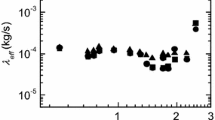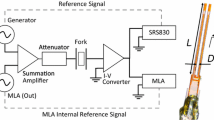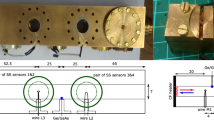Abstract
We present proof-of-concept measurements of the vortex line density generated by a quartz tuning fork resonator probed by the attenuation of second sound in superfluid \(^4\)He at 1.6 K. The force–velocity response of a quartz tuning fork operating at a frequency of 31 kHz exhibited the onset of extra damping at a velocity of 0.5 ms\(^{-1}\). Attenuation of the 5th resonant mode of second sound was observed at the same velocity, indicating the production of vortex lines. Our measurements demonstrate that an increase of the drag coefficient corresponds to the development of quantum turbulence.
Similar content being viewed by others
Avoid common mistakes on your manuscript.
1 Introduction
During the last decade, quartz tuning forks have been employed for turbulence production in superfluids and exhibit a clear critical velocity that can be determined from the measurement of the drag force as a function of velocity [1]. The frequency dependence of this critical velocity is consistent with the square root dependence which can be expected both in classical [2] and quantum [3] turbulence.
In this paper, we present the first measurements demonstrating that the extra damping experienced by a tuning fork above the critical velocity coincides with the production of quantum vorticity. We have used the well-established technique of second sound attenuation [4, 5] to determine the amount of vorticity produced around an oscillating tuning fork at a temperature of 1.6 K, which was chosen purposefully to take advantage of the plateau in the temperature dependence of the second sound velocity [6, 7].
2 Experimental Setup
Our experimental cell, shown in Fig. 1, contains a cylindrical second sound resonator cavity of diameter 10 mm and height 54 mm. Two second sound devices are placed at both ends of the cavity and a tuning fork is mounted in its centre. A 1 -mm-diameter hole, drilled through the cell body, provides access for helium to the resonator cavity. The entire cell was submerged in a helium bath, which was pumped on to achieve low temperatures. During the measurements, the temperature was inferred from the vapour pressure of the helium bath [8].
We used an untrimmed 31 kHz quartz tuning fork in our study. The fork is of moderate size of length \(L = 3576\pm 15\) \(\upmu \)m, tine thickness \(T = 578\pm 3\) \(\upmu \)m and width \(W = 250\pm 3\) \(\upmu \)m (measured with respect to the direction of oscillation [9]). The fork is driven by a voltage V from a function generator which is amplified to achieve the highest velocities by a transformer with a voltage ratio of 6.6 at the fork resonance frequency. The transformer’s output was constantly monitored by a Keithley model 2000 digital multimeter. The current generated by the tuning fork, I, was measured using an IV-converter [10] with a gain of \(10^{3}\) V A\(^{-1}\) and a SR-844 lock-in amplifier.
The driving force applied to the fork is given by \(F = aV/2\), and the velocity of the top of the tines is \(v = I/a\), where a is the experimentally determined fork constant [9]:
Here, \(m_\mathrm{eff}\) is the effective mass of the fork and \(\Delta f_2\) is the measured width of the resonance. The effective mass of the tuning fork is given by \(m_\mathrm{eff} = TWL\rho _\mathrm{q}/4\), where \(\rho _\mathrm{q} =\) 2650 kgm\(^{-3}\) is the density of the fork material, quartz [11]. For our quartz tuning fork, the experimental fork constant is \(a = 8.75\times 10^{-6}\) cm\(^{-1}\).
Second sound was produced and detected by two identical devices. The active part of the second sound device was made from a semi-permeable Nuclepore membrane with sub-micron pores and a 100 nm layer of gold evaporated on one of its sides [4]. The gold-plated side of each membrane was electrically connected to the cell body, which was biased by a DC voltage of 90 V with respect to the brass electrode placed on the membrane’s non-conducting side.
A function generator was used to excite second sound on one side of the cell, whilst the current produced by the sensor on the other side was measured by a lock-in amplifier in current mode.
The exact determination of the vortex line density in this case is complicated due to the presumably non-homogeneous structure of the produced vortex tangle. Nevertheless, it has recently been shown that when using resonance modes of sufficiently high mode number, the quantity measured by second sound attenuation (and calculated by the standard formula applicable to a homogeneous tangle) approaches the mean vortex line density in the studied volume [12]. Therefore, we used the 5th harmonic mode during our experiments and infer the vortex line density, L, from Ref. [5]:
where \(\Delta f_{0}\) and \(A_0\) are the width and amplitude of the unattenuated second sound resonance, A(v) is the attenuated amplitude for fork velocity v, \(\kappa \) is the quantum of circulation and B is the mutual friction coefficient [8]. One should note that this approach will likely yield values systematically shifted from the real ones by some multiplication factor, but since we are interested mainly in relative changes of the vortex line density, this is of no consequence to our interpretation.
Force–velocity curve for the quartz tuning fork at 1.6 K. Inserts show frequency sweeps at high and low drives. We note that the electromechanically obtained tuning fork velocity agrees within 10 % of direct optical measurements [13] (Color figure online)
3 Results and Discussion
Figure 2 shows the variation of the tuning fork peak velocity as a function of applied force in helium at 1.6 K. Each point presented on this graph was obtained by measuring a frequency sweep at a constant drive. The inserts demonstrate that at low fork velocities, the resonant line-shapes were symmetrical and Lorentzian, whereas at high drives, they remain fairly symmetrical, but become non-Lorentzian due to non-linear damping. The observed force–velocity dependence is consistent with previous measurements and shows that at low velocities, the fork exhibits linear damping. Above a certain critical velocity, the damping has a quadratic dependence on tuning fork velocity. The solid and dashed lines in Fig. 2 correspond to linear and quadratic dependencies of force as a function of velocity, respectively.
The linear damping term comprises contributions from the intrinsic fork damping, which is usually negligible, viscous hydrodynamic damping and acoustic damping [14]. The temperature dependence of the linear damping measured between 4.2 and 1.6 K suggests that the acoustic damping contribution is comparable to the hydrodynamic damping at low velocities for this particular fork.
At fork velocities above critical, the extra non-linear damping is caused by the production of turbulence. At \(T = 1.6\) K, turbulence can be produced both in the normal and superfluid components. If a sufficiently dense tangle of quantised vortices exists, it is expected that turbulence in both components will be locked via mutual friction and will exhibit classical-like behaviour [15]. The onset of non-linear damping takes place approximately at a fork peak velocity of \(0.5\pm 0.1\) ms\(^{-1}\), which is higher than expected for turbulence nucleation at 31 kHz [3]. We believe that this can be understood in the following manner: For given experimental conditions, the transition to turbulence occurs at a given critical velocity; however, we observe it only when the non-linear drag force becomes comparable in magnitude to the linear one. Thus, if acoustic damping acting on our fork was negligible [14, 16], the overall linear damping would be notably lower, and the non-linear drag would become apparent (comparable to the linear one) at the true critical velocity, lower than the one we have observed.
Second sound frequency sweeps of the 5th second sound mode at various tuning fork velocities. Note that the change in the resonance frequency is caused by the change in the second sound velocity due to the temperature drift of a few millikelvin and is not due to increased damping (Color figure online)
Top Vortex line density inferred from the second sound attenuation as a function of tuning fork velocity. Bottom drag coefficient experienced by the tuning fork versus tuning fork velocity. The dashed line is a guide for the eye and the shaded area highlights the laminar regime. For details, see text (Color figure online)
The second sound amplitude was measured by continuously sweeping across the resonance whilst the fork was driven at a constant drive (velocity) and frequency.
Figure 3 shows second sound frequency sweeps at various tuning fork velocities. The variation of the second sound amplitude with the tuning fork’s velocity is apparent; the larger the fork velocity, the more second sound is attenuated, indicating that the tuning fork generates an increasing amount of quantised vortex lines which scatter the thermal excitations comprising the normal component. Low velocity data in Fig. 3 show that the baseline may drift; therefore, complete frequency sweeps are required to obtain accurate attenuation of the second sound.
Figure 4 summarises the results of both measurement techniques and shows the dependence of the vortex line density (top) and drag coefficient (bottom) as a function of tuning fork velocity. The vortex line density was inferred using Eq. 2, by setting \(A_0 =\) 0.4402 mV, \(\Delta f_0 =\) 5.3658 Hz and B(1.6 K) \(=\) 1.194 [8]. The drag coefficient is defined as follows:
where \(A = WL\) is the cross-sectional area of the fork perpendicular to the direction of motion and \(\rho _\mathrm{He}\) is the density of helium.
It is clear from Fig. 4 that the onset of vortex production coincides with the onset of non-linear drag experienced by the tuning fork, and that both are clearly related. However, it is difficult to deduce from the current measurements whether the observed critical velocity coincides with the first instabilities in the normal component or with the formation of quantised vortices in the superfluid components or whether one of them becomes turbulent before the other.
4 Conclusions
For the first time, we have demonstrated that the well-established second sound attenuation technique can be used to quantify the vortex line density generated by an oscillator in superfluid helium-4. The average vortex line density created by the vibrations of a 31 kHz quartz tuning fork resonator at a temperature of 1.6 K has been measured using second sound attenuation whilst simultaneously monitoring the drag force acting on the tuning fork.
The force–velocity response of the tuning fork exhibits the onset of excess damping at a velocity of approximately 0.5 ms\(^{-1}\). Attenuation of the 5th resonant mode of second sound is observed above a comparable velocity, indicating that the production of quantised vortices can be directly related to the onset of excess damping. Our measurements clearly demonstrate that an increase of the drag coefficient corresponds to the development of quantum turbulence. These results represent a feasibility study and form the foundation for systematic studies into the instabilities of oscillatory superfluid flows throughout the two-fluid regime.
References
M. Blažková, D. Schmoranzer, L. Skrbek, Transition from laminar to turbulent drag in flow due to a vibrating quartz fork. Phys. Rev. E 75, 025302(R) (2007). arXiv:1014.1234
D. Schmoranzer, M. Králová, V. Pilcová, W.F. Vinen, L. Skrbek, Experiments relating to the flow induced by a vibrating quartz tuning fork and similar structures in a classical fluid. Phys. Rev. E 81, 066316 (2010)
R. Hänninen, W. Schoepe, Universal onset of quantum turbulence in oscillating flows and crossover to steady flows. J. Low Temp. Phys. 158, 410–414 (2010)
S. Babuin, M. Stammeier, E. Varga, M. Rotter, L. Skrbek, Quantum turbulence of bellows-driven \(^4\)He superflow: steady state. Phys. Rev. B 86, 134515 (2012)
S. Babuin, E. Varga, L. Skrbek, E. Lévêque, P.-E. Roche, Effective viscosity in quantum turbulence: a steady-state approach. Europhys. Lett. 106, 24006 (2014)
R.D. Maurer, M.A. Herlin, Second sound velocity in helium II. Phys. Rev. 76, 948 (1949)
R.J. Donnelly, The two-fluid theory and second sound in liquid helium. Phys. Today 62, 34 (2009)
R.J. Donnelly, C.F. Barenghi, The observed properties of liquid helium at the saturated vapor pressure. J. Phys. Chem. Ref. Data 27, 1217 (1998)
R. Blaauwgeers, M. Blažková, M. Človečko, V.B. Eltsov, R. de Graaf, J.J. Hosio, M. Krusius, D. Schmoranzer, W. Schoepe, L. Skrbek, P. Skyba, R.E. Solntsev, D.E. Zmeev, Quartz tuning fork: thermometer, pressure- and viscometer for helium liquids. J. Low Temp. Phys. 146, 537 (2007)
S. Holt, P. Skyba, Electrometric direct current I/V converter with wide bandwidth. Rev. Sci. Instrum. 83, 064703 (2012)
D.I. Bradley, M. Človečko, S.N. Fisher, D. Garg, E. Guise, R.P. Haley, O. Kolosov, G.R. Pickett, V. Tsepelin, D. Schmoranzer, L. Skrbek, Crossover from hydrodynamic to acoustic drag on quartz tuning forks in normal and superfluid \(^4\)He. Phys. Rev. B 85, 014501 (2012)
E. Varga, S. Babuin, L. Skrbek, Second-sound studies of coflow and counterflow of superfluid \(^4\)He in channels. Phys. Fluids 27, 065101 (2015)
S.L. Ahlstrom, D.I. Bradley, M. Človečko, S.N. Fisher, A.M. Guenault, E.A. Guise, R.P. Haley, O. Kolosov, P.V.E. McClintock, G.R. Pickett, M. Poole, V. Tsepelin, A.J. Woods, Frequency-dependent drag from quantum turbulence produced by quartz tuning forks in superfluid \(^4\)He. Phys. Rev. B 89, 014515 (2014)
D. Schmoranzer, M. La Mantia, G. Sheshin, I. Gritsenko, A. Zadorozhko, M. Rotter, L. Skrbek, Acoustic emission by quartz tuning forks and other oscillating structures in cryogenic He-4 fluids. J. Low Temp. Phys. 163, 317–344 (2011)
M. Blažková, D. Schmoranzer, L. Skrbek, W.F. Vinen, Generation of turbulence by vibrating forks and other structures in superfluid He-4. Phys. Rev. B 79, 054522 (2009)
J. Rysti, J.T. Tuoriniemi, Quartz tuning forks and acoustic phenomena: Application to superfluid helium. J. Low Temp. Phys. 177, 133–150 (2014)
Acknowledgments
We would like to thank E. Varga for useful comments and fruitful discussions. We appreciate the help of L. Doležal with the construction of the setup. This work was supported by the European Community Framework Programme 7, EuHIT - European High-performance Infrastructures in Turbulence, Grant Agreement No. 312778, as well as the Engineering and Physical Sciences Research Council Grants EP/I028285/1, EP/L000016/1 and the Czech Science Foundation under Project GAČR 203/14/02005S. DS acknowledges institutional support under UNCE 2040.
Author information
Authors and Affiliations
Corresponding author
Rights and permissions
About this article
Cite this article
Jackson, M.J., Kolosov, O., Schmoranzer, D. et al. Measurements of Vortex Line Density Generated by a Quartz Tuning Fork in Superfluid \(^{4}\)He. J Low Temp Phys 183, 208–214 (2016). https://doi.org/10.1007/s10909-015-1397-4
Received:
Accepted:
Published:
Issue Date:
DOI: https://doi.org/10.1007/s10909-015-1397-4








